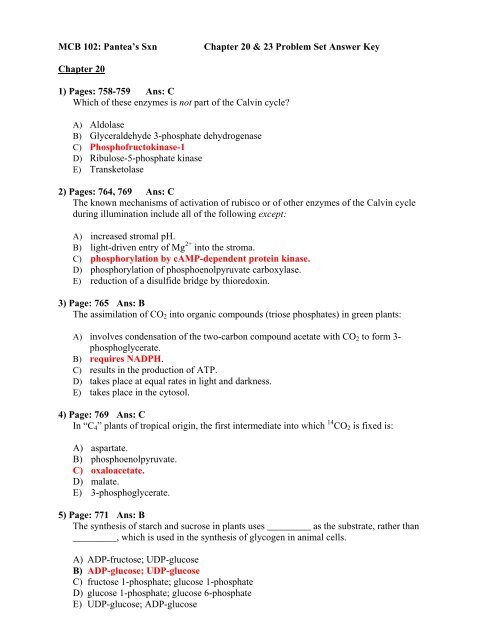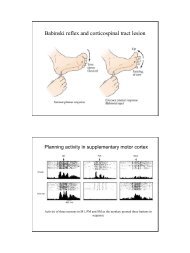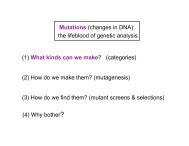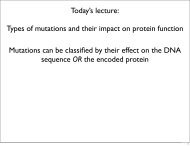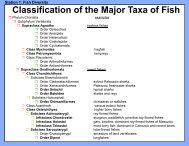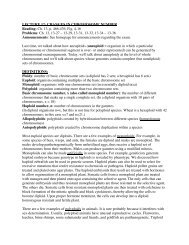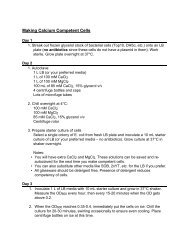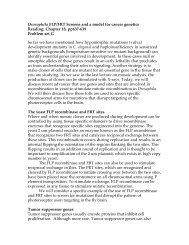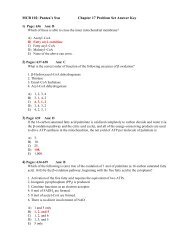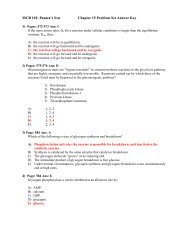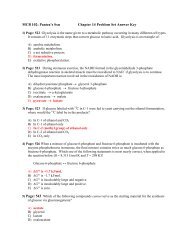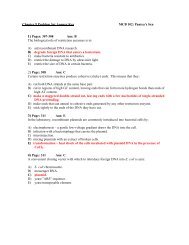MCB 102: Pantea's Sxn - Molecular and Cell Biology
MCB 102: Pantea's Sxn - Molecular and Cell Biology
MCB 102: Pantea's Sxn - Molecular and Cell Biology
You also want an ePaper? Increase the reach of your titles
YUMPU automatically turns print PDFs into web optimized ePapers that Google loves.
<strong>MCB</strong> <strong>102</strong>: Pantea’s <strong>Sxn</strong> Chapter 20 & 23 Problem Set Answer Key<br />
Chapter 20<br />
1) Pages: 758-759 Ans: C<br />
Which of these enzymes is not part of the Calvin cycle?<br />
A)<br />
B)<br />
C)<br />
D)<br />
E)<br />
A)<br />
B)<br />
C)<br />
D)<br />
E)<br />
A)<br />
B)<br />
C)<br />
D)<br />
E)<br />
Aldolase<br />
Glyceraldehyde 3-phosphate dehydrogenase<br />
Phosphofructokinase-1<br />
Ribulose-5-phosphate kinase<br />
Transketolase<br />
2) Pages: 764, 769 Ans: C<br />
The known mechanisms of activation of rubisco or of other enzymes of the Calvin cycle<br />
during illumination include all of the following except:<br />
increased stromal pH.<br />
light-driven entry of Mg 2+ into the stroma.<br />
phosphorylation by cAMP-dependent protein kinase.<br />
phosphorylation of phosphoenolpyruvate carboxylase.<br />
reduction of a disulfide bridge by thioredoxin.<br />
3) Page: 765 Ans: B<br />
The assimilation of CO2 into organic compounds (triose phosphates) in green plants:<br />
involves condensation of the two-carbon compound acetate with CO2 to form 3phosphoglycerate.<br />
requires NADPH.<br />
results in the production of ATP.<br />
takes place at equal rates in light <strong>and</strong> darkness.<br />
takes place in the cytosol.<br />
4) Page: 769 Ans: C<br />
In “C4” plants of tropical origin, the first intermediate into which 14 CO2 is fixed is:<br />
A) aspartate.<br />
B) phosphoenolpyruvate.<br />
C) oxaloacetate.<br />
D) malate.<br />
E) 3-phosphoglycerate.<br />
5) Page: 771 Ans: B<br />
The synthesis of starch <strong>and</strong> sucrose in plants uses _________ as the substrate, rather than<br />
_________, which is used in the synthesis of glycogen in animal cells.<br />
A) ADP-fructose; UDP-glucose<br />
B) ADP-glucose; UDP-glucose<br />
C) fructose 1-phosphate; glucose 1-phosphate<br />
D) glucose 1-phosphate; glucose 6-phosphate<br />
E) UDP-glucose; ADP-glucose
6) Page: 780 Ans: E<br />
Which one of the following reactions, cycles, or pathways is not found in plant systems?<br />
A) The Calvin cycle<br />
B) The gluconeogenesis pathway<br />
C) The glyoxalate cycle<br />
D) The rubisco reaction<br />
E) The urea cycle<br />
7) Page: 754<br />
Show the reaction catalyzed by ribulose 1,5-bisphosphate carboxylase/oxygenase (rubisco).<br />
Ans: Ribulose 1,5-bisphosphate + CO 2 2 (3-phosphoglycerate)<br />
(For the details of the reaction, see Fig. 20-7, p. 756.)<br />
8) Page: 762<br />
Explain why both ATP <strong>and</strong> NADPH are required for the operation of the Calvin cycle, <strong>and</strong><br />
why these two reactants are required in different amounts.<br />
Ans: ATP is required in two reactions of the Calvin cycle: the formation of 1,3bisphosphoglycerate<br />
from 3-phosphoglycerate (2 ATP per CO2 fixed) <strong>and</strong> the conversion of<br />
ribulose 5-phosphate into ribulose 1,5-bisphosphate (1 ATP per CO2 fixed). NADPH is<br />
required in the reduction of 1,3-bisphosphoglycerate to glyceraldehyde 3-phosphate (2<br />
NADPH per CO2 fixed). Thus the operation of the cycle consumes 3 ATP <strong>and</strong> 2 NADPH per<br />
CO2 fixed. (See Fig. 20-14, p. 762.)<br />
9) Page: 767<br />
Describe the reaction sequence by which 2-phosphoglycolate (produced when O2 replaces<br />
CO2 as substrate for rubisco) is converted to serine. Name each enzyme <strong>and</strong> any cofactors<br />
required <strong>and</strong> indicate the subcellular compartment in which the reaction takes place.<br />
Ans: 2-phosphoglycolate is converted to glycolate by a phosphatase in the chloroplast.<br />
Glycolate is transported to the peroxisome <strong>and</strong> converted to glyoxylate by glycolate oxidase.<br />
The glyoxylate is then converted in the peroxisome to glycine by a transaminase that requires<br />
pyridoxal phosphate. Finally, two molecules of glycine are converted to serine + NH3 + CO2<br />
by the enzyme glycine decarboxylase, which is located in the mitochondrion.<br />
10) Page: 764<br />
How does glyceraldehyde 3-phosphate formed in the chloroplast stroma by the Calvin cycle<br />
reactions enter the cytosol?<br />
Ans: It is converted to dihydroxyacetone phosphate or to 3-phosphoglycerate <strong>and</strong> carried into<br />
the cytosol by the Pi-triose phosphate antiporter, a specific transporter in the inner<br />
chloroplast membrane. (See Fig. 20-16, p. 764.)
11) Pages: 771-772<br />
Explain the utility to plants in using sucrose as the transport form of carbon.<br />
Ans: Sucrose is a nonreducing disaccharide, with its glycosidic linkage between the anomeric<br />
carbons of glucose <strong>and</strong> fructose. The unavailability of these normally reactive carbons prevents<br />
sucrose from reacting nonenzymatically with amino acids or proteins, <strong>and</strong> this unusual bond is not<br />
hydrolyzed by amylases or other common carbohydrate-cleaving enzymes.<br />
12) Pages: 766-768<br />
Describe the oxygenase activity of ribulose 1,5-bisphosphate carboxylase/oxygenase (rubisco) <strong>and</strong><br />
explain why this reaction is undesirable from the point of view of a plant.<br />
Ans: The condensation of molecular oxygen with ribulose 1,5-bisphosphate yields 3phosphoglycerate<br />
<strong>and</strong> the two-carbon compound phosphoglycolate. Phosphoglycolate has no known<br />
metabolic role; its carbon is salvaged by a series of reactions that consume O2 <strong>and</strong> produce CO2 − the<br />
“photorespiration” process. The salvage pathway requires energy, <strong>and</strong> therefore the oxygenase<br />
reaction of rubisco represents a net energy cost to the plant cell in which it occurs.
Chapter 23<br />
1) Page: 887 Ans: D<br />
Insulin is an example of a(n) ____________ hormone.<br />
A) catecholamine<br />
B) eicosanoid<br />
C) paracrine<br />
D) peptide<br />
E) steroid<br />
2) Pages: 893-896 Ans: E<br />
Which of the following statements about metabolism in the mammalian liver is false?<br />
A) Most plasma lipoproteins are synthesized in the liver.<br />
B) The enzymatic complement of liver tissue changes in response to changes in the diet.<br />
C) The liver synthesizes most of the urea produced in the body.<br />
D) The presence of glucose 6-phosphatase makes liver uniquely able to release glucose into<br />
the bloodstream.<br />
E) Under certain conditions, most of the functions of the liver can be performed by<br />
other organs.<br />
3) Page: 898 Ans: B<br />
In skeletal muscle:<br />
A) amino acids are an essential fuel.<br />
B) at rest, fatty acids are the preferred fuel.<br />
C) large quantities of triacylglycerol are stored as fuel.<br />
D) phosphocreatine can substitute for ATP as the direct source of energy for muscle<br />
contraction.<br />
E) stored muscle glycogen can be converted to glucose <strong>and</strong> released to replenish blood<br />
glucose.<br />
4) Page: 900 Ans: A<br />
Which one of the following statements is true?<br />
A) The brain prefers glucose as an energy source, but can use ketone bodies.<br />
B) Muscle cannot use fatty acids as an energy source.<br />
C) In a well-fed human, about equal amounts of energy are stored as glycogen <strong>and</strong> as<br />
triacylglycerol.<br />
D) Fatty acids cannot be used as an energy source in humans because humans lack the<br />
enzymes of the glyoxylate cycle.<br />
E) Amino acids are a preferable energy source over fatty acids.
5) Page: 902 Ans: D<br />
When blood glucose is abnormally high, the pancreas releases:<br />
A) epinephrine.<br />
B) glucagon.<br />
C) glucose.<br />
D) insulin.<br />
E) trypsin.<br />
6) Page: 895<br />
Describe five possible fates for glucose 6-phosphate in the liver.<br />
Ans: Possible answers include: (1) conversion to liver glycogen; (2) dephosphorylation <strong>and</strong><br />
release of glucose into bloodstream; (3) oxidation via the pentose phosphate pathway; (4)<br />
oxidation via glycolysis <strong>and</strong> the citric acid cycle; (5) oxidation to acetyl-CoA, which then<br />
serves as precursor for synthesis of triacylglycerols, phospholipids, <strong>and</strong> cholesterol. (See Fig.<br />
23-13, p. 895.)


